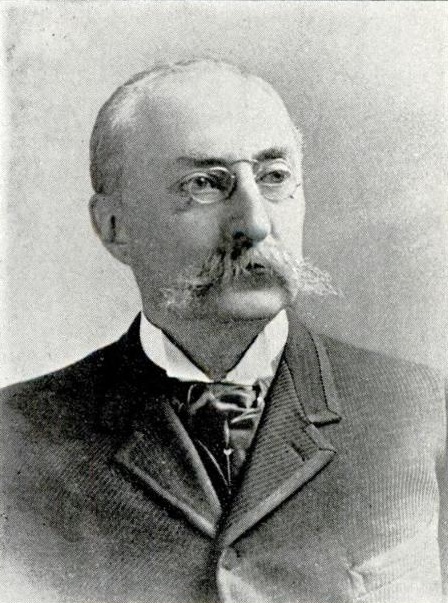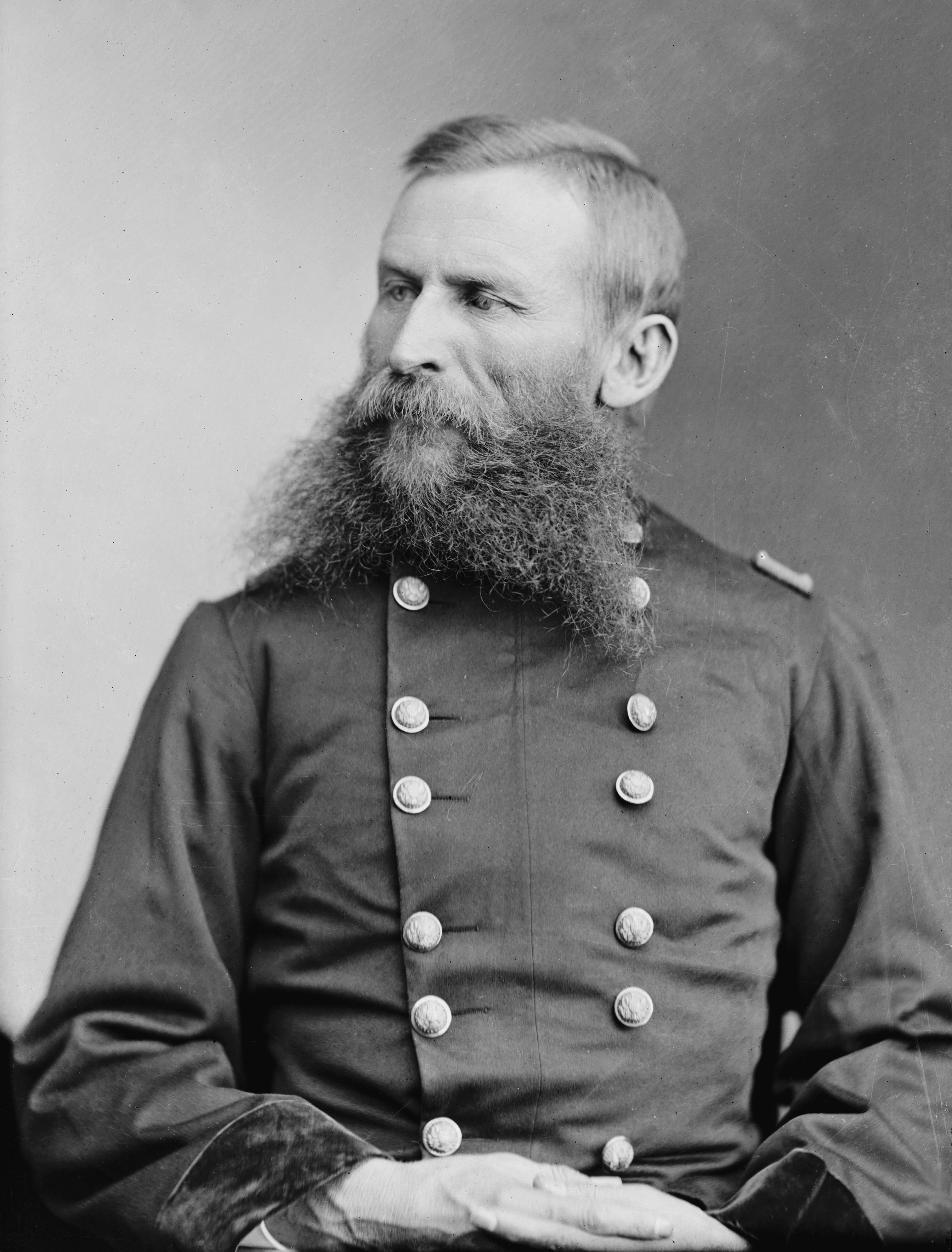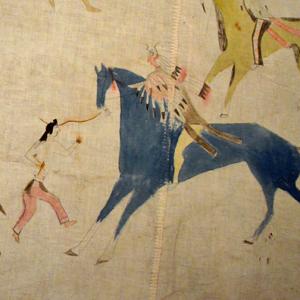|
He Dog
He Dog (Lakota: Šúŋka Bloká) (ca. 1840–1936), a member of the Oglala Lakota, was closely associated with Crazy Horse during the Great Sioux War of 1876-77. Biography Born in the spring of 1840 on the headwaters of the Cheyenne River near the Black Hills, He Dog was the son of a headman named Black Stone and his wife, Blue Day, a sister of Red Cloud. His youngest brother was Grant Short Bull. By the 1860s, He Dog and his brothers had formed a small Oglala Lakota band known as the Cankahuhan or Soreback Band which was closely associated with Red Cloud's Bad Face band of Oglala. He Dog and his relatives participated in the Great Sioux War of 1876-77. After the treaty commission failed to persuade the Lakota to give up the Black Hills, the President had an ultimatum sent in January 1876 to the northern bands to come into the agencies or be forced in by the army. He Dog was encamped with the Soreback band on the Tongue River when the message was delivered. He Dog's bro ... [...More Info...] [...Related Items...] OR: [Wikipedia] [Google] [Baidu] |
Oglala Lakota
The Oglala (pronounced , meaning 'to scatter one's own' in Lakota language, Lakota) are one of the seven subtribes of the Lakota people who, along with the Dakota people, Dakota, make up the Sioux, Očhéthi Šakówiŋ (Seven Council Fires). A majority of the Oglala live on the Pine Ridge Indian Reservation in South Dakota, the eighth-largest Indian reservation, Native American reservation in the United States. The Oglala are a List of federally recognized tribes, federally recognized tribe whose official title is the called the Oglala Sioux Tribe of the Pine Ridge Reservation, South Dakota. History Oglala elders relate stories about the origin of the name "Oglala" and their emergence as a distinct group, probably sometime in the 18th century. Conflict with the European settlers In the early 19th century, Europeans and American passed through Lakota territory in increasing numbers. They sought furs, especially beaver fur at first, and later bison fur. The fur trade changed th ... [...More Info...] [...Related Items...] OR: [Wikipedia] [Google] [Baidu] |
Joseph J
Joseph is a common male name, derived from the Hebrew (). "Joseph" is used, along with " Josef", mostly in English, French and partially German languages. This spelling is also found as a variant in the languages of the modern-day Nordic countries. In Portuguese and Spanish, the name is "José". In Arabic, including in the Quran, the name is spelled , . In Kurdish (''Kurdî''), the name is , Persian, the name is , and in Turkish it is . In Pashto the name is spelled ''Esaf'' (ايسپ) and in Malayalam it is spelled ''Ousep'' (ഔസേപ്പ്). In Tamil, it is spelled as ''Yosepu'' (யோசேப்பு). The name has enjoyed significant popularity in its many forms in numerous countries, and ''Joseph'' was one of the two names, along with ''Robert'', to have remained in the top 10 boys' names list in the US from 1925 to 1972. It is especially common in contemporary Israel, as either "Yossi" or "Yossef", and in Italy, where the name "Giuseppe" was the most com ... [...More Info...] [...Related Items...] OR: [Wikipedia] [Google] [Baidu] |
1930 Deaths
Events January * January 15 – The Moon moves into its nearest point to Earth, called perigee, at the same time as its fullest phase of the Lunar Cycle. This is the closest moon distance at in recent history, and the next one will be on January 1, 2257, at . * January 26 – The Indian National Congress declares this date as Independence Day, or as the day for Purna Swaraj (Complete Independence). * January 28 – The first patent for a field-effect transistor is granted in the United States, to Julius Edgar Lilienfeld. * January 30 – Pavel Molchanov launches a radiosonde from Pavlovsk, Saint Petersburg, Slutsk in the Soviet Union. February * February 10 – The Việt Nam Quốc Dân Đảng launch the Yên Bái mutiny in the hope of ending French Indochina, French colonial rule in Vietnam. * February 18 – While studying photographs taken in January, Clyde Tombaugh confirms the existence of Pluto, a celestial body considered a planet until redefined as a dwarf planet ... [...More Info...] [...Related Items...] OR: [Wikipedia] [Google] [Baidu] |
1840s Births
__NOTOC__ Year 184 ( CLXXXIV) was a leap year starting on Wednesday of the Julian calendar. At the time, it was known as the Year of the Consulship of Eggius and Aelianus (or, less frequently, year 937 ''Ab urbe condita''). The denomination 184 for this year has been used since the early medieval period, when the Anno Domini calendar era became the prevalent method in Europe for naming years. Events By place China * The Yellow Turban Rebellion and Liang Province Rebellion break out in China. * The Disasters of the Partisan Prohibitions ends. * Zhang Jue leads the peasant revolt against Emperor Ling of Han of the Eastern Han dynasty. Heading for the capital of Luoyang, his massive and undisciplined army (360,000 men), burns and destroys government offices and outposts. * June – Ling of Han places his brother-in-law, He Jin, in command of the imperial army and sends them to attack the Yellow Turban rebels. * Winter – Zhang Jue dies of illness while his ... [...More Info...] [...Related Items...] OR: [Wikipedia] [Google] [Baidu] |
Brulé
The Sicangu are one of the seven ''oyates'', nations or council fires, of Lakota people, an Indigenous people of the Northern Plains. Today, many Sicangu people are enrolled citizens of the Rosebud Sioux Tribe of the Rosebud Indian Reservation and Lower Brule Sioux Tribe of the Lower Brule Reservation in South Dakota. Distribution Many Sičhą́ǧu people live on the Rosebud Indian Reservation in southwestern South Dakota and are enrolled in the federally recognized Rosebud Sioux Tribe, also known in Lakȟóta as the ''Sičhą́ǧu Oyáte.'' A smaller population lives on the Lower Brule Indian Reservation, on the west bank of the Missouri River in central South Dakota, and on the Pine Ridge Indian Reservation, also in South Dakota, directly west of the Rosebud Indian Reservation. The different federally recognized tribes are politically independent of each other. Name The Sicangu Lakota are known as Sičhą́ǧu Oyáte in Lakȟóta, which translates to "Burnt Thighs N ... [...More Info...] [...Related Items...] OR: [Wikipedia] [Google] [Baidu] |
Mari Sandoz
Mari Susette Sandoz (May 11, 1896 – March 10, 1966) was a Nebraska novelist, biographer, lecturer, and teacher. She became one of the West's foremost writers, and wrote extensively about pioneer life and the Plains Indians.Bristow, David L. - "The Enduring Mari Sandoz", ''Nebraska Life'', Jan/Feb 2001. Early life and education Marie Susette Sandoz was born on May 11, 1896, near Hay Springs, Nebraska, the eldest of six children born to Swiss immigrants, Jules and Mary Elizabeth (Fehr) Sandoz. Until the age of nine, she spoke only German. Her father was said to be a violent and domineering man, who disapproved of her writing and reading. Her childhood was spent in hard labor on the home farm, and she developed snow blindness in one eye after a day spent digging the family's cattle out of a snowdrift. She graduated from the eighth grade at the age of 17, secretly took the rural teachers' exam, and passed. She taught in nearby country schools without ever attending high scho ... [...More Info...] [...Related Items...] OR: [Wikipedia] [Google] [Baidu] |
Walter Mason Camp
Walter Mason Camp (1867–1925) was an American editor, author, railroad expert and historical researcher. Biography Walter Mason Camp was born in Camptown, Pennsylvania, on April 21, 1867. He attended public school in Wyalusing, Pennsylvania before attending the Pennsylvania State College until 1891 and then the University of Wisconsin from 1895 to 1896. He was a student of civil engineering and his post-graduate studies focused on electricity and steam. From 1897 until his death, he was the editor of '' The Railway and Engineering Review'' (later renamed ''Railway Review''), a railroad construction and engineering journal published in Chicago. He was a member of many different organizations relating to engineering and history. Camp married Emeline L. F. Sayles in 1898. They had no children. He died unexpectedly at Kankakee, Illinois, on August 3, 1925, after living in Chicago for many years. Camp also spent time interviewing and documenting the experiences of Native Americans a ... [...More Info...] [...Related Items...] OR: [Wikipedia] [Google] [Baidu] |
Garrick Mallery
Garrick Mallery (April 25, 1831 in Wilkes-Barre, Pennsylvania – October 24, 1894) was an American ethnologist specializing in Plains Indian Sign Language, Native American sign language and pictographs. Family His father was Judge Garrick Mallery (judge), Garrick Mallery, who was born April 17, 1784, and graduated at Yale College in 1808. He was a member of the Pennsylvania legislature from 1827 to 1830, and was distinguished for the zeal with which he promoted prison reform. In 1831 he was appointed judge of the third judicial district, composed of the Pennsylvania counties of Berks County, Pennsylvania, Berks, Northampton County, Pennsylvania, Northampton, and Lehigh County, Pennsylvania, Lehigh. He resigned from the bench in 1836 and removed to Philadelphia, where he practiced as a lawyer for many years. He died in Philadelphia on July 6, 1866. Garrick's mother was the judge's second wife. She was descended from John Harris Jr. (settler), John Harris, Jr., the founder of ... [...More Info...] [...Related Items...] OR: [Wikipedia] [Google] [Baidu] |
Battle Of The Little Bighorn
The Battle of the Little Bighorn, known to the Lakota people, Lakota and other Plains Indians as the Battle of the Greasy Grass, and commonly referred to as Custer's Last Stand, was an armed engagement between combined forces of the Lakota Sioux, Northern Cheyenne, and Arapaho tribes and the 7th Cavalry Regiment of the United States Army. It took place on June 25–26, 1876, along the Little Bighorn River in the Crow Indian Reservation in southeastern Montana Territory. The battle, which resulted in the defeat of U.S. forces, was the most significant action of the Great Sioux War of 1876. Most battles in the Great Sioux War, including the Battle of the Little Bighorn, were on lands those natives had taken from other tribes since 1851. The Lakotas were there without consent from the local Crow tribe, which had a treaty on the area. Already in 1873, Crow chief Blackfoot had called for U.S. military actions against the native intruders. The steady Lakota incursions into treaty ar ... [...More Info...] [...Related Items...] OR: [Wikipedia] [Google] [Baidu] |
Battle Of The Rosebud
The Battle of the Rosebud (also known as the Battle of Rosebud Creek) took place on June 17, 1876, in the Montana Territory between the United States Army and its Crow Nation, Crow and Shoshone, Shoshoni allies against a force consisting mostly of Lakota people, Lakota Sioux and Northern Cheyenne Native Americans in the United States, Indians during the Great Sioux War of 1876. The Cheyenne called it the Battle Where the Girl Saved Her Brother because of an incident during the fight involving Buffalo Calf Road Woman. General George Crook's offensive was stymied by the Indians, led by Crazy Horse, and he awaited reinforcements before resuming the campaign in August. Background After their victory in Red Cloud's War and with the signing of the Treaty of Fort Laramie (1868), the Lakota and their Northern Cheyenne allies were allocated a reservation including the Black Hills, in Dakota Territory and a large area of unceded territory in what became Montana and Wyoming. Both areas we ... [...More Info...] [...Related Items...] OR: [Wikipedia] [Google] [Baidu] |
Red Cloud Agency
The Red Cloud Agency was an Indian agency for the Oglala Lakota as well as the Northern Cheyenne and Arapaho, from 1871 to 1878. It was located at three different sites in Wyoming Territory and Nebraska before being moved to South Dakota. It was then renamed the Pine Ridge Reservation. Red Cloud Agency No. 1 (1871-1873) As stipulated in the Fort Laramie Treaty (1868), the US government built Indian agencies for the various Lakota and other Plains tribes. These were forerunners to the modern Indian reservations. In 1871, the Red Cloud Agency was established on the North Platte River near Fort Laramie. Two year later it was moved to an eastern corner of Nebraska, then two years later to South Dakota. Red Cloud Agency No. 2 (1873-1877) In August 1873, the agency was moved to the northwestern corner of Nebraska, near the present town of Crawford. Constructed on a hill overlooking the White River, the agency buildings included a large warehouse, offices, home for the ag ... [...More Info...] [...Related Items...] OR: [Wikipedia] [Google] [Baidu] |
Lakota People
The Lakota (; or ) are a Native Americans in the United States, Native American people. Also known as the Teton Sioux (from ), they are one of the three prominent subcultures of the Sioux people, with the Eastern Dakota (Santee) and Western Dakota (). Their current lands are in North Dakota, North and South Dakota. They speak — the Lakota language, the westernmost of three closely related languages that belong to the Siouan languages, Siouan language family. The seven bands or "sub-tribes" of the Lakota are: * (, Burned Thighs) * ("They Scatter Their Own") * (, Without Bows) * (Hunkpapa, "End Village", Camps at the End of the Camp Circle) * (Miniconjou, "Plant Near Water", Planters by the Water) * ("Blackfeet" or "Blackfoot") * (Two Kettles) Notable Lakota persons include (Sitting Bull) from the , (Touch the Clouds) from the Miniconjou; (Black Elk), (Red Cloud), and (Billy Mills), all ; (Crazy Horse) from the and Miniconjou, and (Spotted Tail) from the ... [...More Info...] [...Related Items...] OR: [Wikipedia] [Google] [Baidu] |






